29 Top Chatbot Statistics For 2024: Usage, Demographics, Trends
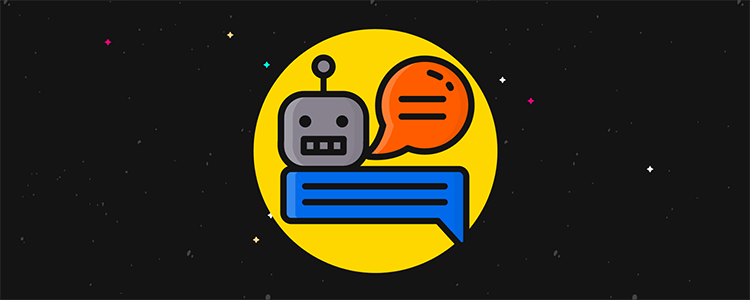
Looking for a way to improve customer service and save money? Chatbots may be just what you need.
Chatbots are no longer a gimmick to show customers how technologically advanced your company is. They’re an extremely useful tool for businesses looking to improve and streamline their customer service processes.
They can help to complete a range of tasks from answering common queries to making sales and reducing cart abandonment.
In this article, we’ll be taking a look at the latest chatbot statistics that can help you learn more about what chatbots are and how they can be used to save your business time and money.
Editor’s top picks – chatbot statistics
These are our most interesting statistics about chatbots:
- 23% of customer service companies are currently using AI chatbots. (Source: Salesforce)
- On Facebook Messenger alone, there are over 300,000 chatbots in operation. (Source: Venture Beat)
- Online retail stores have the highest rates of chatbot ‘acceptance’. (Source: Invesp)
Chatbot usage statistics
Want to know more about who’s using chatbots and how they’re being used? Here are some chatbot statistics relating to usage and industry size.
1. 23% of customer service companies are currently using AI chatbots
Whilst many companies are keen to take advantage of AI chatbots, however, the number of companies actually using them is still relatively low.
According to a report published by Salesforce around 23% of customer organizations were currently using AI chatbots. However, the report also found that a further 31% of customer service organizations planned to start using them within the next 18 months.
Source: Salesforce
2. 80% of people have interacted with a chatbot at some point
Although the industry is still growing, chatbots are becoming a feature of many websites and social media pages. According to statistics published by Userlike, the majority of internet consumers had interacted with chatbots at least once that year – 80% to be exact.
This is great news for the chatbot industry, as it shows that a good percentage of internet users have already had some experience with chatbots and are becoming more comfortable with them. This will allow the industry to continue to grow.
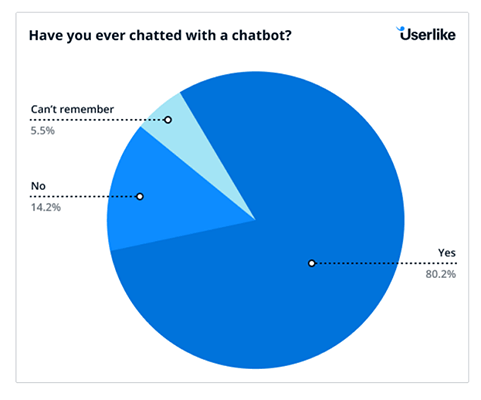
Source: Userlike
3. The global chatbot marketing revenue reached $83.4 million this year
According to figures published by Statista, revenue generated from the chatbot industry amounted to around $83 million in 2021.
As part of the same study, Statista calculated the predicted revenue growth of the industry over the next few years. The study found that the market will continue to grow substantially and by 2027 it’s expected to be worth around $454.8 million.
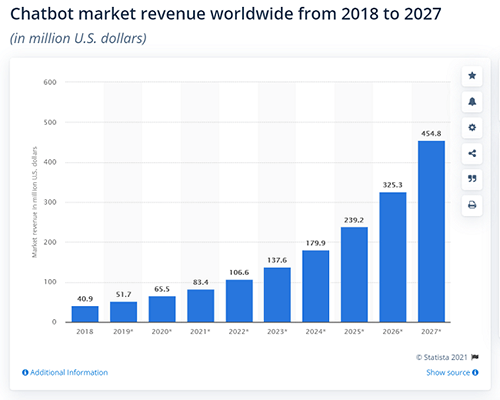
Source: Statista1
4. Chatbots handle full conversations around 69% of the time
If you’ve not interacted with many chatbots, then it would be easy to assume they are just in place to greet customers and provide generic information. However, AI chatbot technology is extremely advanced and is capable of dealing with much more personalized and complex tasks.
According to a report published by Com100, chatbots are capable of handling full conversations with customers and do so almost 70% of the time. Of course, chatbots can’t deal with every query, but they can be used to assist with common queries from start to finish.
Source: Comm100
5. On Facebook Messenger alone, there are over 300,000 chatbots in operation
For businesses, managing customer queries on multiple platforms such as Facebook, Twitter and your own website can be demanding and time-consuming. However, it’s more than possible to reduce this workload with the help of chatbots.
Facebook in particular is a hub for chatbot usage. According to statistics, there are approximately 300,000 chatbots operating on Facebook. Using chatbots on Facebook allows companies to respond to queries 24/7 and create a closer connection with their customers.

Source: Venture Beat
If you’d like to learn more, be sure to check out our article on Facebook Messenger statistics.
6. Chatbots are mostly used to quickly answer customer queries
There are many uses for chatbots, such as collecting user data, gather feedback and reviews or personalize user experiences. However, the most common use for chatbots is to answer simple queries. According to a report published by Drift, they are mostly used to provide quick answers to customer queries.
This can be anything from informing customers when a live agent will next be available or providing answers to commonly asked questions. Chatbots can reduce the demand for live agents significantly, and can help to ensure that customers get an instant response.
Source: Drift
7. Chatbots were the fastest-growing communication channel used by brands in 2020
The same study from Drift showed that chatbots are the fastest-growing communication channel used by brands. In an age where everything is on-demand, customers do not want to wait to hear back from live agents for simple queries, and brands know this.
That’s what makes chatbot technology so popular and why many brands are implementing them as part of their overall CRM strategies.
Source: Drift
8. Chatbots are more popular in Europe than in the US and Japan
Although chatbots seem to offer benefits to both businesses and consumers, not everybody is sold on the idea. Across the world, different countries have quite different responses to the technology.
According to a study published by Business Insider, chatbots are most well-received in Europe. The study showed that 50% of respondents in France viewed chatbots in a positive light. However, in the US and Japan, only 32% and 33% respectively viewed the technology positively.
Source: Business Insider
Chatbot engagement statistics
AI chatbots are a fairly new concept and not all consumers are ready for the change. Here are some chatbot statistics relating to engagement and how consumers feel about the new technology.
9. 68% of users enjoy the speed at which chatbots answer
When it comes to deciding whether or not to use chatbots, it’s important to consider your customers and whether or not it would benefit their consumer journey. The good news is that on the whole, people enjoy using chatbots to find information and deal with their queries. According to Userlike, 68% of users enjoy the convenience that comes with using chatbots, in particular how quickly they receive a response.
However, it’s a good idea to consider your target audience when implementing a chatbot, as some groups and demographics may favor more traditional customer support options.
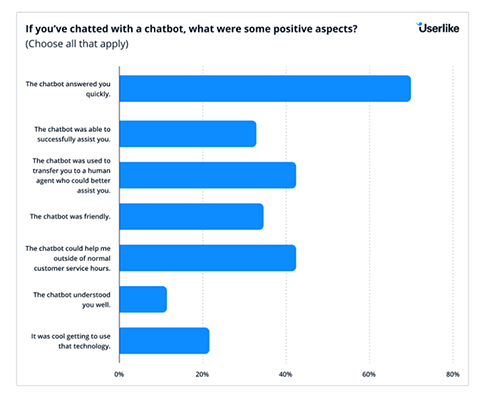
Source: Userlike
10. Chatbots have response rates of up to 40%
If you’re keen to use chatbots to send marketing messages or gather information from your customers, it could be a great choice. Chatbots have a quite high response rate in comparison to other forms of communication like email.
According to an article by Matthew Barby claimed that on average, response rates for chatbot messages can be as high as 35-40%. In fact, the same article found that companies with engaged audiences that used chatbots could even have response rates as high as 90%.
Source: Matthew Barby
11. 33% of consumers find chatbots ‘very effective’ at resolving their issues
When using chatbots, it’s important to ensure that they are fit for their purpose and are adding real value to your customer’s experience. However, it seems that a good percentage of companies using chatbots are meeting this target effectively.
According to a statistic published by Statista, 1/3 of consumers found that chatbots were ‘very effective’ in resolving their queries. 54% reported that the chatbots were ‘somewhat effective’ and only 13% reported that they were ‘not at all effective’.
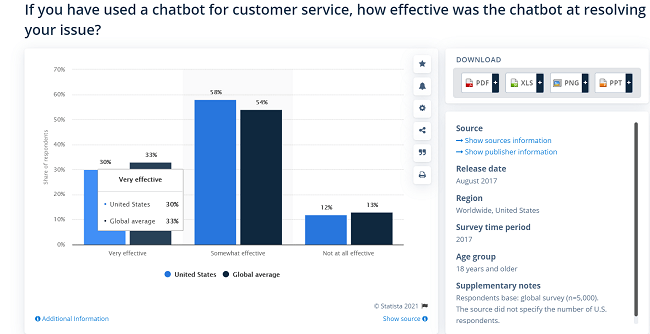
Source: Statista2
12. 40% don’t care whether they engage with a chatbot or a human agent
One of the reasons many business owners hesitate when it comes to chatbot usage is for fear that they will worsen their customer’s experience. The general belief is that people much prefer to talk to real humans than using chatbots.
However, the figures tell a different story. An article published by HubSpot showed that 40% of people are indifferent and couldn’t care less if they were talking to a human. In fact, some studies have shown that there are many cases where chatbots are the preferred method of contact.
Source: HubSpot
13. Online retail stores have the highest rates of chatbot ‘acceptance’
Chatbots are used a lot in e-commerce scenarios and studies show that consumers are receptive to this, and accepting of the new technology. A study showed that 34% of e-commerce customers accept chatbots as a valid and useful tool.
If you compare this figure to other industries, it’s clear to see this is an extremely high acceptance rate. For example, chatbots used in banking only have a 20% acceptance rate, and the insurance industry is even lower at only 13%.
Source: Invesp
14. Almost 90% of chatbot experiences are neutral or positive
On the whole, chatbot usage is something that consumers like. Around 90% of consumers’ experiences with chatbots are either neutral or positive. That means only 10% of consumers have reported that their experience has been less than satisfactory.
This is great news for businesses looking to implement chatbots technology as there is little risk that the innovation will upset customers. The most likely response from customers will be either neutral or positive.
Source: Drift
15. On average, chatbots chats have almost 90% satisfaction rates
According to comm100, interactions with chatbots actually have a higher satisfaction rate than live chats with humans. On average, the satisfaction rate for chatbots is around 87.58% which is whole 2% higher than the rate for live chat conversations.
Since chatbots are capable of dealing with many queries, using them can often prevent unsatisfactory interactions between service staff and customers. In some cases, customer service agents may get confused during live chats, or come across as rude, which can all be avoided when using live chat.
Source: Comm100
16. 24/7 support is the main benefit of chatbots according to consumers
According to Drift, people agree that the number 1 benefit of using chatbots is being able to get a response from brands 24/7. This is a huge perk for businesses that are operating on an international scale, as customers worldwide can get immediate responses no matter where your customer service centres are based.
Equally, it means that customers that don’t have complicated queries can be segmented from your regular customer service workflow and receive responses almost immediately, instead of having to wait 24 hours or more for a resolution.
Source: Drift
Chatbot business and marketing statistics
Chatbots offer a unique opportunity for businesses to streamline their process, market their product and improve their customer service. Here are some chatbot statistics relating to business and marketing.
17. Chatbots help 55% of businesses generate high-quality leads
Chatbots aren’t just about saving time and money when it comes to customer service, they can also help to make the most of your web traffic and generate high quality leads.
As we mentioned earlier, chatbots have a really high response rate, and this can be extremely useful for getting your site visitors into your funnel. According to Drift, chatbots are already helping more than half of all business with their lead generation efforts.
Source: Drift
18. Using chatbots can reduce customer service costs by as much as 30%
For businesses, saving money where possible is always a priority and this is one of the main benefits to using chatbots.
Chatbots can help you to cut back on customer service costs, and ensure that you customer service staff are using their time efficiently. According to IBM using chatbots can help businesses reduce their customer service costs by as much as 30%.
Source: IBM
19. Chatbots are expected to save businesses 2.5 billion hours and $8 billion in the next two years
As more and more business realize the benefits of chatbots, usage is growing at a rapid rate. That means more and more businesses with be saving both time and money in years to come. Juniper research predicts that around 2.5 billion hours will be saved by business using chatbots in just two years. Equally, $8 billion can be save thanks to chatbot use.
Source: Juniper Research
20. 47% of consumers reported they are interested in buying products using chatbots
If you’re thinking about using chatbots to aid your ecommerce efforts, you might just have the right idea. According to an article published by HubSpot, almost 50% of people are interested in buying products using a chatbot.
Online shopping is the new normal, and people are keen to try out new ways to shop in the digital age such as using chatbots and AI. The best part is that they’re easy to create and integrate with modern ecommerce platforms.
Source: HubSpot
21. 82% of consumers say that getting instant responses is important when contacting brands
If you needed more evidence that businesses can benefit from using chatbots, here it is! 82% of consumers say that getting instant responses from brands is important to them. However, without the support of technology, this is almost impossible, especially for large brands with a lot of customers. Thankfully, chatbots can ensure that every customer gets some form of instant response, regardless of their query.
Source: Business2community
Chatbot challenges statistics
Like all new technologies, there are some challenges relating to the introduction and adoption of chatbots. Here are some chatbots statistics relating to challenges in the industry.
22. Some consumers are concerned about using chatbots because they ‘can’t solve complex issues’
Although chatbots seem to be popular with many web users, consumers still have some concerns about using them.
According to NewVoiceMedia, a good proportion of users are concerned about whether or not AI is adequate for responding to their queries. The article stated that some are concerned that chatbots ‘can’t solve complex issues’ and therefore they are hesitant to use the chatbots in the first place.
Source: NewVoiceMedia
23. Almost half of consumers think chatbots are used to prevent them from speaking to live agents
Another common challenge that businesses face when using chatbots is the idea that they are somehow preventing consumers from contacting real people.
Around 50% of people believe that companies use chatbots to deflect service responsibilities and prevent them from being able to contact real live agents. Whilst using chatbots in more serious scenarios can be frustrating, on the whole, chatbots help customers receive support faster, rather than preventing them getting the support they need.
Source: NewVoiceMedia
24. The majority of people (60%) still prefer speaking to live agents to using chatbots
Although chatbots offer a good alternative for resolving simple issues, many people still aren’t sold on the idea. According to a study by Userlike, 60% of people would still prefer to talk to a live agent than use a chatbot even if it meant they had to wait in a queue.
However, this could be due to many things. For example, some people may prefer to use traditional methods to contact business like telephone due to hesitancy about using computers. Perhaps as younger generation get older, chatbots will become the most popular type of communication.
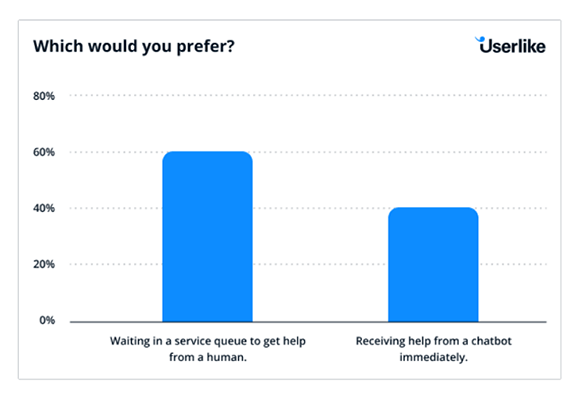
Source: Userlike
25. 60% of consumers are also concerned that chatbots cannot understand their queries
Another statistic from Business Insider showed that people using chatbots aren’t confident that they are actually understanding their queries. 60% of users share this belief, and this can lead to customers using both chatbots and live chat to double check that the chatbot provided the right information.
For companies using chatbot software that charges per message, this can become costly, so it’s important for businesses to try and build trust in the chatbots capabilities among their audience.
Chatbot trends statistics
Chatbots are growing in popularity year on year, and there is still a lot of potential for growth and adoption. Here are some chatbot statistics related to trends we can expect to see in the industry over the next few years.
26. By 2022, up to 90% of health and banking queries are expected to be handled by chatbots
As the use of chatbots becomes more prevalent, it’s expected that some industries will be able to utilize them more than others. For example, industries like health and banking can benefit substantially from the implementation of chatbots.
According to CNBC, we can expect that between 75% and 90% of all queries in this industry will be handled by chatbots by 2022. This will help to reduce demand for customer service agents in this area, and make it easier for customers to access the information they’re looking for.
Source: CNBC
27. Around ⅓ of consumers would like to make reservations using chatbots
Another industry that may benefit heavily from chatbots in the future is the food and hospitality industry. According to drift, 1/3 of customers would like to make reservations for restaurants and hotels using chatbots.
For most people, talking on the phone to service staff can be a hassle, and chatbots make it easier and quicker for customers to make reservations for their favorite venues. With this in mind, we can expect to see more business in this industry using chatbots in the next few years.
Source: Drift
28. By 2023, chatbots are expected to generate over $100 billion in ecommerce transactions
As we mentioned earlier in the article, e-commerce stores and online retailers are seeing high acceptance rates from customers when it comes to using chatbots.
In the next few years, use of chatbots in ecommerce is set to continue growing in popularity and become more advanced. According to Juniper Research, we can expect to see chatbots generating over $100 billion in ecommerce transactions by 2023.
Source: Juniper Research
29. Over 70% of admin tasks in the healthcare industry could be automated using AI and chatbot technology
One industry that has been hit particularly hard in the last couple of years is the healthcare industry. In light of the pandemic, hospitals and health facilities have been pushed to their limits and there has been a huge demand for staff to undertake admin roles.
Thankfully, chatbots and other AI technology may be able to help relieve some of the pressure on healthcare admin staff. According to an article published by Insider Intelligence, around 70% of healthcare admin tasks could be performed solely by chatbots and AI.
Source: Insider Intelligence
Chatbot statistics sources
Final thoughts
As you can see from the statistics above, chatbots are extremely useful. Consumers like them, businesses like them and they’re extremely useful and versatile. No matter what industry your business is in, there is a way you can use chatbots to improve and streamline your processes.
If you want to learn more about ways you can support your customers other than using chatbots, check out our article on the best chatbot builders.
Alternatively, you may find these marketing statistics roundups useful:
